In the early morning of June 14th, Beijing time, the Fed, which has attracted much attention from investors in the international market, officially landed for the second time in the year. The Federal Reserve issued an interest rate statement saying that the Federal Open Market Committee (FOMC) members voted unanimously to raise the federal funds target interest rate range by 25 basis points to the 1.75%-2% range, in line with market expectations. This is also the Fed’s opening of this round in December 2015. The seventh rate hike since the interest rate hike cycle.
The Fed meeting statement deleted the statement in the May resolution statement that "the federal funds rate will remain at the current low level for a long period of time". For the interest rate hike, the "adjustment" is replaced by "further gradual increase". Regarding inflation expectations, the statement said that the long-term inflation expectations indicator was “almost unchangedâ€, removing the phrase “market-based inflation compensation indicators are still low†in the May statement.
The statement said that the short-term risks facing the economy are roughly balanced, and the employment market continues to tighten; the US economic activity has steadily increased, while the growth rate was previously considered moderate. It is expected that interest rates will be raised twice in 2018, and interest rates will be raised three times in 2019; further interest rate hikes in the future will be consistent with the continued growth of the US economy in the medium term, strong labor market, and inflation close to 2%.
The Fed’s median forecast for the early morning showed that the federal funds rate at the end of 2018 is expected to be 2.375% (expected to be 2.125% in March), which means that the Fed raised its interest rate hike expectations to four times during the year. The Fed also announced that it will raise the excess reserve ratio (IOER) by 20 basis points.
After the announcement, the market also raised the probability of the Fed raising interest rates in December. According to CME "Federal Watch", the probability of the Fed raising interest rates four times during the year was raised to 52.4% from less than 40% before the release of the resolution, but the possibility of half-half indicates that the market still has a certain degree of whether the Fed will raise the rate hike during the year. Skeptical attitude. Analysts believe that this is because a series of uncertainties such as geopolitics and trade may still affect economic growth.
Fed statement full text
Information obtained by the Federal Open Market Committee (FOMC) after the May meeting showed that the job market continued to grow and economic activity has been growing at a steady pace. On average, employment growth has been strong in recent months and the unemployment rate has fallen. Recent data shows that household spending growth has accelerated and firm fixed investment continues to grow strongly. Overall inflation compared to the same period last year and core inflation rates not counting food and energy prices have moved closer to 2%. Overall, the longer-term inflation expectations index has not changed much.
The committee will seek to promote employment maximization and price stability in accordance with statutory objectives. The committee expects that further gradual upward adjustment of the federal funds rate target range will be consistent with the continued expansion of economic activity, strong job market conditions and close to the 2% symmetry target of the Commission in the medium term of inflation. The economic outlook risks appear to be roughly balanced.
In view of the realized and expected employment market conditions and inflation, the committee decided to raise the federal funds rate target range to 1.75-2%. The monetary policy stance is kept loose, so it will support the employment market to remain strong and drive inflation to continue to rise to 2%.
In determining the timing and scale of future adjustments to the Fed interest rate target range, the committee will assess the realized and expected economic conditions associated with employment maximization and the 2% symmetric inflation target. The assessment will take into account a wide range of information, including indicators of job market conditions, inflationary pressures and inflation expectations, as well as data reflecting financial markets and international developments.
The FOMC members who voted for the Fed's monetary policy resolution include: Fed Chairman Powell, Vice Chairman Dudley, Richmond Fed President Barking, Atlanta Fed President Bostik, Governor Brainard, Cleveland Fed Chairman Meister, and Deputy Financial Supervisor Chairman Quars and San Francisco Fed President Williams.
Federal Reserve Chairman Powell's key points
After the release of the June policy statement, Federal Reserve Chairman Powell held the second press conference. Compared with the hawkish policy statement, Powell’s speech is relatively neutral, emphasizing that the economy is very good, and that the Fed will be very cautious, to ensure that the pace of policy tightening will not be too fast, and reiterate that the rate hike is too fast or too slow. Both may cause damage. If the economic response is not good, the rate hike path can be reversed in time.
A press conference will be held at every meeting from next year: Powell announced that from January next year, every meeting will hold a press conference, and will continue to update quarterly economic expectations. The market has already anticipated this and interprets this as a hawkish signal, as the increase in the number of press conferences means that the interest rate hike will further increase.
However, Powell said that the market should not over-interpret the number of press conferences to double, and does not imply any rate hikes or time points changes, just want to better communicate with the market.
The economic situation is very good: Powell said that the US economy is in very good condition, fiscal policy is boosting the economy, salary growth is gradually rising, will gradually rise to 2%-3%, unemployment rate is 3.8%, and is still going down, overall The growth prospects are still positive, and discussing the potential economic growth rate of 3% is not an idiotic dream.
Inflation is near the 2% target, and inflation is not expected to rise: Powell said that the recent inflation data is encouraging, inflation has reached 2% close to the inflation target; inflation will fluctuate within the range, oil prices may push up inflation, but the impact of oil prices It is temporary and will not overreact to inflation above 2%. The inflation victory is to reach the 2% target and stay at that level. Fed officials' inflation expectations for two years (2020) are 2.1%, still not far from the 2% symmetry inflation target, and the Fed model does not show that inflation is likely to rise.
Powell stressed that it is most important to “anchor†inflation expectations at 2%. In addition to preventing inflation from being too high, it is also important to prevent inflation from falling below 2%, otherwise it will reduce the available policy space.
It is expected to further increase interest rates, but will be very cautious: Powell said that it is expected to further increase interest rates, interest rates will reach a neutral range at a "relatively fast level", when the interest rate is close to the neutral level, in the monetary policy statement Keeping the word "loose" will no longer be appropriate. The Fed will remain open and continue to observe economic data, based on the next data to determine the level of neutral interest rates.
But Powell also stressed that the Fed will be very cautious and ensure that the pace of policy tightening will not be too fast.
Financial risks are still manageable: Powell said that financial risks are still under control, and that non-financial companies are closely watching. The leverage ratio of non-financial companies is actually very high, and household credit growth is not considered too fast. The past two economic cycles have not ended because of high inflation, but because financial instability has ended, so special vigilance is needed.
Withdrawal of forward-looking guidance: Powell said that since the Fed’s introduction of forward-looking guidance, the US economy has strengthened, and it is time to revoke the forward-looking guidance.
Fiscal policy: Powell said that on the whole, the FOMC believes that fiscal policy will substantially support demand in the next three years, but there are many uncertainties in the fiscal policy impact; I hope to see the tax reform bring greater impact.
Trade Disputes: Powell said that the Fed does not seek to play a role in trade policy and will not comment on specific trade actions; there is currently no trade policy that has any impact on the data; trade policy is currently more of a risk, not Start to have an impact.
Don't worry about the yield curve upside down: the US bond yield curve leveled to a 11-year high. When asked if they were worried about the US bond yield curve hanging upside down, Powell said that he was not worried about this. Fed officials talked about the topic. It is to find the right policy and to correct the understanding of natural neutral interest rates, that is, not to worry about the risk of economic recession that is flattened or even reversed.
US stock markets reacted violently to $ huge shock
On Wednesday, after the Fed announced a rate hike resolution, the three major stock indexes of the US stock market fell rapidly. After the Fed Chairman Powell’s press conference released the US economy’s stable and optimistic expectations, the US stock market rebounded briefly. In the end, the three major US stock indexes quickly dipped and eventually closed down.

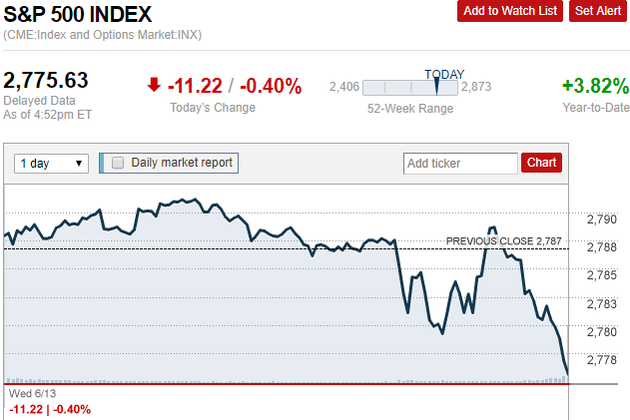
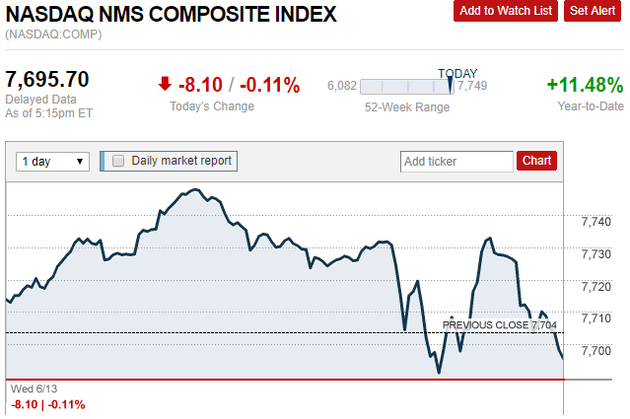
The interest rate hike caused the dollar to jump, but Powell jumped in a straight line after the speech, and eventually did not rise and fall, and the short-term fluctuations were severe.
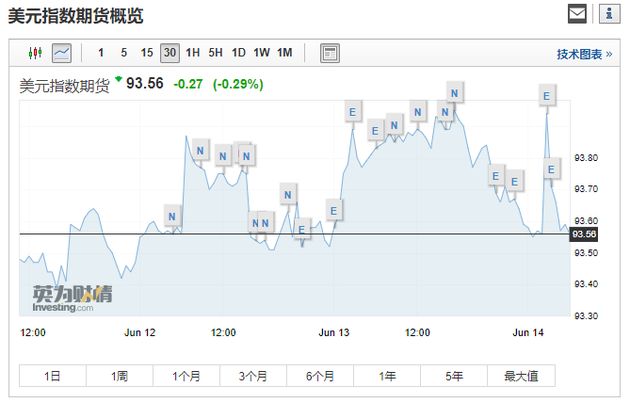
US bond prices plummeted and yields soared. The 10-year US Treasury yield once rose above 3%, hitting a two-week high.
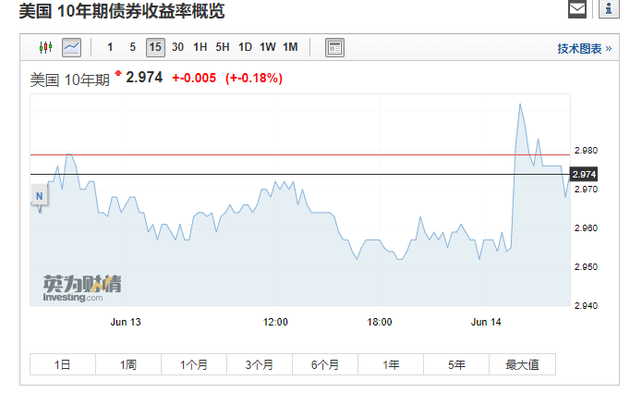
What is the impact of this interest rate hike on domestic funds?
When entering the middle of the year, the domestic funds are very concerned about the trend. Historically, the contradiction between liquidity supply and demand in the middle of the year is often prominent, and the money market is prone to large fluctuations. The most typical example is 2013. In June 2013, the representative 7-day repo rate R007 of the interbank market rose to a maximum of 11.62%, setting a historical extreme. In addition, in June 2011, R007 rose to 9.04%, the third highest in history. With these impressive records, it’s no surprise that liquidity is being paid attention at the end of the year.
The impact of the Fed’s first rate hike in March this year has just passed, and the subsequent meeting of interest rates has begun. Since the Fed’s interest rate hike last time, the liquidity of the domestic market has slightly tightened, and the central bank’s open market operation has shown a trend of net withdrawal of funds. Wind data shows that since March 22, the central bank has achieved a net return of 281.5 billion yuan through operations such as reverse repurchase, MLF and treasury cash deposits.
1. Reverse repurchase
Wind data shows that since March 22, the central bank has carried out 52 reverse repurchase operations, which are 7 days, 14 days and 28 days, with a total investment of 3.03 trillion yuan; while the number of periods expires more A total of 59 times, a return of 3.09 trillion yuan of funds, and a net return of 60 billion yuan. Reverse repurchase, as the most frequent open market operation of the central bank, remained stable in the past three months and slightly tightened.
As shown below:
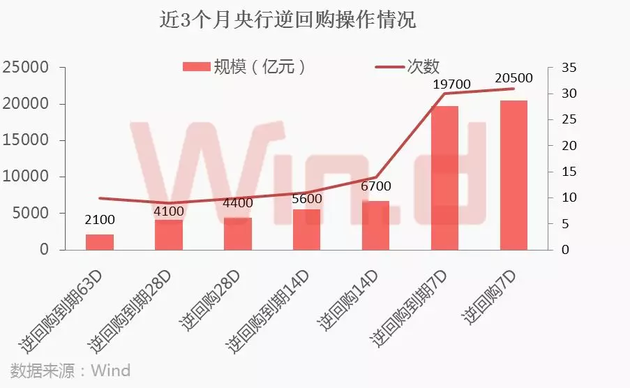
2, MLF
MLF operations are mainly based on one year, which can better meet the medium and long-term liquidity needs of financial institutions. Although the number of central bank operations through MLF in the past three months is small, it is basically maintained once a month, but the overall scale is not small. Wind data shows that the central bank has invested a total of 986.5 billion yuan through MLF operations, and has withdrawn from the end of 1,258 billion yuan, a substantial net return of 271.5 billion yuan, shrinking market liquidity. The following table:
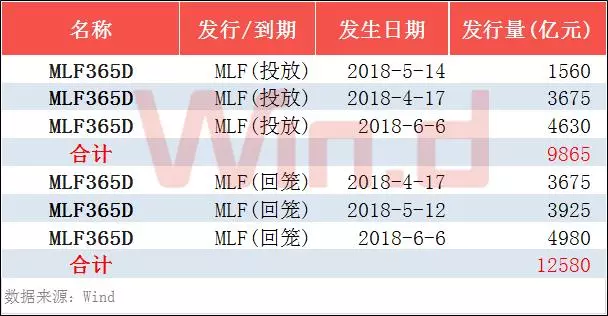
3. Treasury cash deposit
The treasury cash will be deposited and the treasury cash balance will be deposited in commercial banks. In the past three months, the central bank has had fewer open market operations, only 250 billion yuan, with a maturity of 200 billion yuan and a net investment of 50 billion yuan. This is also the only one of the three operating tools to achieve a small net investment, adding a little liquidity.
The industry said that although the market showed some concerns about liquidity in the middle of the year, the repair of liquidity expectations should not be overkill. Recently, the central bank released liquidity through the “MLF expanded collateral range + MLF excess sequel†and maintained a neutral and loose attitude. Under this policy orientation, the central bank’s intention to maintain smooth liquidity has not changed, and the possibility of liquidity tightening during the middle of the year is not high. Although the expectation of lowering the RRR in the short term has failed, the intention of the central bank to maintain liquidity has not changed. In view of the completion of the issuance of nearly 70% of the issuance of the inter-season deposit receipts and the signs of a fall in the issuance rate, the liquidity in the middle of the year is expected to be better than expected, and the funds are stable. The intersea season is still expected.
What is the impact on the domestic market?
According to industry insiders, this time the Fed’s rate hike can be said to be completely within the market’s expectations. It’s not surprising that the interest rate hike is 25 basis points. The loss of suddenness has already been partially absorbed by the market in advance, thus the Chinese capital. The impact of the market is directly reduced.
1. Renminbi
JPMorgan Chase expects the exchange rate of the yuan against the US dollar to remain stable, reaching 6.25 by the end of 2018. Capital flows will be more balanced.
Some insiders also believe that the recent strengthening of the US dollar and the slight depreciation of the RMB against the US dollar, but the effective exchange rate of the RMB has remained basically stable and even appreciated, that is, the appreciation of the RMB against non-US currencies such as the euro and the British pound. This shows that the current market sentiment is relatively stable, there is no obvious expectation of RMB depreciation. In recent years, the inclusion of RMB in foreign exchange reserves in some countries will also drive the increase in demand for RMB assets, which is conducive to the stability of the RMB exchange rate. Overall, it is expected that the RMB exchange rate will continue to fluctuate in both directions in the future, and it will remain basically stable. Cross-border capital flows will continue to maintain a basic balance or a small net inflow.
2. The stock market
Zhao Huihui, chief analyst of Qihui Finance, believes that with the deepening of de-leverage and the investigation of shadow banks, the stock market is extremely weak and vulnerable to the spillover effect of the Fed’s interest rate hike. The Fed’s rate hike is likely to strengthen the city’s Guoxin Securities. In the short term, the US dollar interest rate hike has limited impact on A shares. The market is dominated by a narrow range of fluctuations, and investor sentiment may increase market volatility. Therefore, the strategy needs to maintain a certain strength, which should not be affected by market optimism or pessimism. When the market is quickly adjusted back, the strategy can be turned positive, and the intervention in under-estimation of high-quality companies can be carried out in batches. The future monetary tightening of the market led to a weak stock market performance.
BOC International said it expects A-shares to remain in a moderately volatile and rising trend in the medium term; in the short term, shocks remain the main feature of the market. Investors are advised to adopt a market-neutral alpha strategy. Holding a variety of high-quality stocks, including a small number of innovative, growth stocks and excellent consumer stocks that can clearly prove the value of their own investment, the empty Shanghai and Shenzhen 300 Index, to obtain a solid absolute investment income.
CITIC Jiantou believes that the Fed’s interest rate hike will have little impact on A-shares, and the four major industries will have opportunities. From the perspective of the market as a whole, the Fed’s interest rate hike will affect the upward trend of long-end interest rates, thus limiting the valuation of global risk assets. From the perspective of the A-share market, if the use of enhanced capital controls to maintain stability, then the A-share market is less affected.
From an industry perspective, the Fed’s interest rate hike has led to upward pressure on the US dollar exchange rate. Export-oriented industries with US dollars and US dollar assets have benefited from the industry, and vice versa. There are opportunities in industries such as electronics, textiles, overseas engineering, and national large banks.
From the historical data, the impact of the Fed rate hike on A shares is not very obvious, and A shares still operate according to their own rules. Let's take a look at the trend of A shares before and after the Fed rate hike:
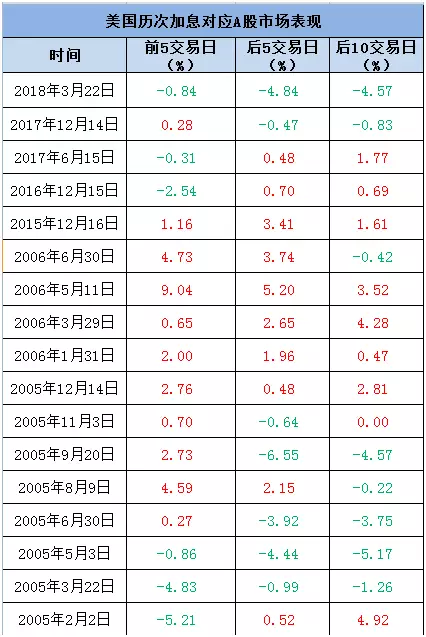
3, the property market
After the interest rate hike, the property market interest rate continues to rise. And for the buyers, it is definitely not good, especially the marginal buyers.
At present, the third rate hike is to raise interest rates to 2.00%-2.25%. If the fourth rate hike is likely to break through our psychological interest rate red line!
4. Bond market
BOC International said that the Fed’s continued interest rate hike will further contain the monetary policy of the People’s Bank of China. The People's Bank is likely to follow a small rate hike. It should be said that about 3.7-3.8% should be the reasonable horizontal range of the 10-year national debt YTM that the central bank currently recognizes. In addition, it is also necessary to consider the factor of the gap in the yield of government bonds between China and the United States. If the US 10-year government bond yields return to more than 3% after the US Federal Reserve raises interest rates in June, the spread between China and the United States will shrink to around 60 BP.
Huachuang Bond said that the domestic liquidity gap at the end of the quarter still exists, and the cross-season funds are still not to be taken lightly; overseas super-week strikes, monetary policy tightening and geopolitical risks still need to be highly concerned. The uncertainty facing the bond market has not eased. It is recommended that institutions control leverage and duration and operate with caution.
The monarch's solid revenue believes that after the release of financial data, the logic of financing contraction is further strengthened. Although the bond market is still facing the Fed's interest rate hike and economic data test on Thursday, these factors have a very limited impact on the bond market. When the interest rate is traded, it is necessary to buy when it falls, and it must be sold when it rises; if it comes out, it must be bought, and it will be good to sell it.
Will the People's Bank of China follow the interest rate hike?
China's central bank "increasing interest rates" has two meanings, one is to raise the benchmark interest rate for deposits and loans; the other is to operate interest rates with monetary policy instruments represented by reverse repurchase and MLF.
Looking back at the central bank's recent monetary policy, since 2016, in addition to the Fed rate hike in June 2017, the People's Bank of China has not followed up, after the Fed raised the federal funds target rate, the central bank raised the open market operation (OMO), The policy interest rates represented by the Medium Term Lending Facilitation (MLF) are followed up. From a specific operation, the MLF is replaced by a directional leveling or the best policy option.
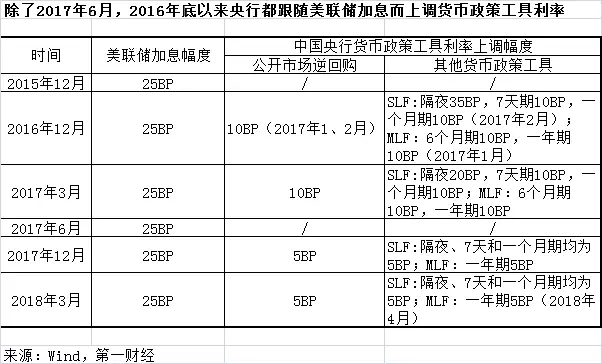
The chief analyst of fixed income of CITIC Securities clearly stated that the interest rate hike or not needs to be weighed against the current internal and external factors. "China-US interest rate differential and RMB exchange rate are external factors, which will have a certain impact on whether China's central bank will raise interest rates. However, the domestic economic fundamentals are facing certain downward pressure. Expanding domestic demand and reducing corporate financing costs have become the main objectives of economic and financial work, and the internal environment. Restricting monetary policy tightening, the pressure on raising interest rates is relatively high.†He further pointed out that the central bank may “rate interest rate†5BP and combine liquidity operations such as MLF and other open market operations to “rate interest rates†according to the domestic economic situation.
Chinese central bank counselor Sheng Songcheng said that although the Chinese central bank may still raise interest rates slightly in the open market, in the long run, China does not need to follow the Fed to raise interest rates, nor does it have to raise the benchmark interest rate for deposits and loans. In terms of absolute value, China's interest rate is much higher than that of foreign countries, and CPI is not high. The problem of financing difficulties and financing for SMEs has not been fundamentally resolved.
Haitong Securities Jiang Chao commented on the "Fed rate hike" comment, saying that China's open market does not rule out interest rate hikes, but long-term Sino-US interest rates tend to be decoupled. Considering that there is still a large gap between the current central bank operating interest rate and the market interest rate, there is a certain distortion. Coupled with the appreciation of the US dollar, there will be some pressure on the RMB exchange rate. Therefore, the Chinese central bank will still take this opportunity to symbolically The open market raises interest rates, but the impact on domestic liquidity is very limited. In the long run, China is the second largest economy in the world. The Chinese economy is a big country economy. As the RMB exchange rate becomes more market-oriented, Sino-US interest rates will tend to be decoupled.
(The content or data of the article is for reference only and does not constitute investment advice. Investors operate according to this, at their own risk.)
Humic Acid Fertilizer
Humic Acid Fertilizer
Hebei Monband Water Soluble Fertilizer Co., Ltd. , https://www.wsfertilizer.com